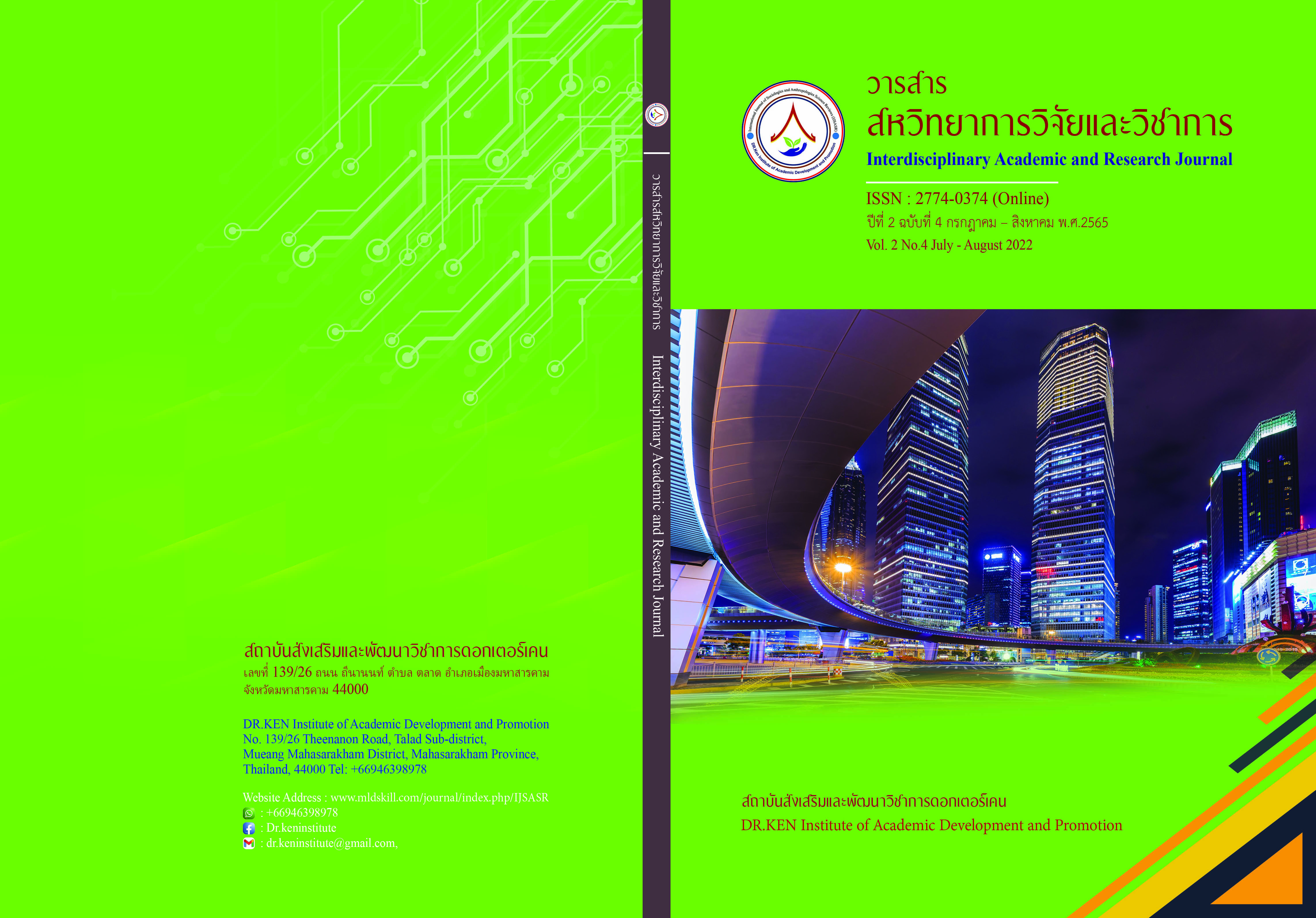The Implementation of the Provisional Release Process
DOI:
https://doi.org/10.14456/iarj.2022.67Keywords:
Provisional Release; , Implementation; , Accused; , DefendantAbstract
The provisional release process allows the accused or defendant to be released from the custody of the official or court for a specified period so that the accused or defendant is not held in custody or detention for longer than necessary during the investigation or trial. It is also a measure to relax the restrictions on the freedom of the accused or defendant to be able to live normally without being confined in a prison without affecting the rights and freedoms of the accused or defendant. Thus, this research article aimed to examine the circumstances, problem situations, and factors affecting the implementation of the provisional release process, which could lead to recommendations for the effective development of Thailand's provisional release process. The study was conducted using a qualitative research method. A total number of 41 key informants, which were selected purposively, were included. They consisted of experts in criminal law and criminal justice, executives and practitioners in criminal justice, and the accused and defendants under investigation. The research instruments included in-depth interviews, focus group discussions, and content analysis.
The results showed that the current circumstances and problem situations of Thailand's provisional release process consist of 1) economic disparity of the accused or defendant concerning access to justice, where provisional release is rather linked to collateral; 2) provisional release in the interrogation and trial stages that differs in the problem situations, with provisional release during the trial having a relatively greater magnitude and importance of the problem than in the interrogation; 3) standardization of the provisional release based on the discretion of the judge; 4) provisional release support in the investigation stage that lacks a risk management mechanism or tool; 5) some practitioners who still lack knowledge, understanding as well as skills, especially the attitude towards risk management in provisional release; 6) communication for raising awareness and understanding of the provisional release process among stakeholders, communication for encouraging participation of the public sector, and communication for improving and promoting the performance of the personnel; 7) laws relating to provisional release; 8) risk management in provisional release, especially the use of electronic monitoring (EM) bracelets as part of the provisional release that are still found limited both in terms of quantity and quality, as well as the conditions for using the equipment that must be suitable for specific risks. As for the factors contributing to the implementation of the provisional release process, they included 1) internal and external communication, 2) policy pressure, 3) distribution and allocation of resources, 4) inter-agency integration and coordination, 5) database integration, 6) civic participation, and 7) attitudes of practitioners. The recommendations made included setting up a central body to monitor and control those who are brought to provisional release; setting up a committee to consider cases of detention; adjusting attitudes or perspectives of practitioners; strengthening community-based mechanisms; inter-agency integration; raising awareness of the public and stakeholders, and recognizing the importance of respecting the human rights of the accused and defendants.
References
กฤตพงษ์ พัชรภิญโญพงศ์. (2562). การแก้ไขปัญหาและอุปสรรคของการควบคุมผู้ต้องขังนอกเรือนจำด้วยกำไลอิเล็กทรอนิกส์. วารสารนวัตกรรมและการจัดการ. 4, 29-39.
คมสัน สุขมาก. (2563). สิทธิของผู้ต้องหาในการอุทธรณ์คำสั่งไม่ปล่อยตัวชั่วคราวในชั้นสอบสวน. วารสารวิชาการศรีปทุม ชลบุรี. 16 (3), 89-98.
ทินกรณ์ ทองบุราณ, กรันต์ ธนธูเทพ, พิศิษฐ์ กันธทิพย์ และ มนไท ประมูลจักโก (2560). การคุ้มครองสิทธิ เสรีภาพของจำเลยในคดีอาญา: กรณีการขอปล่อยตัวชั่วคราว. วารสารราชธานีนวัตกรรมทางสังคมศาสตร์. 1 (2), 50-58.
ธันว์ บุุณยะตุุลานนท์. (2563). อุปกรณ์อิเล็กทรอนิกส์กับการปล่อยตัวชั่วคราวผู้ต้องหาหรือจำเลย. วารสารรัฎฐาภิรักษ์. 62 (2), 31-40.
นันท์นภัส สุปิยะพันธ์ ประทีป ทับอัตตานนท์ และสอาด หอมมณี. (2558). การปล่อยชั่วคราวโดยการนำมาตรการคุมขังแบบไม่ควบคุมตัว โดยใช้เครื่องมืออิเล็กทรอนิกส์. วิทยานิพนธ์ปริญญานิติศาสตรมหาบัณฑิต: มหาวิทยาลัยธรรมศาสตร์.
ประยุทธ ประชุมชน. (2565). มาตรการปล่อยตัวชั่วคราวกับการปฏิบัติในประเทศไทย (สัมภาษณ์) ผู้พิพากษาศาลแขวงดอนเมือง, ศาลแขวงดอนเมือง. 30 มิถุนายน 2565.
ปรีชริน แขดอน และวรรณวิภา เมืองถ้ำ. (2564). ปัญหาการนำอุปกรณ์อิเล็กทรอนิกส์ (EM) มาใช้กับการปล่อยชั่วคราวในคดีอาญา:ศึกษากรณีศาลอาญาตลิ่งชัน. วารสารสังคมศาสตร์เพื่อการพัฒนาท้องถิ่น มหาวิทยาลัยราชภัฏมหาสารคาม. 5 (2), 62-71.
ปาลิดา มณีโชติ. (2559). ปัญหาการนำเครื่องมืออิเล็กทรอนิกส์มาใช้กับการปล่อยชั่วคราวจำเลยในชั้นพิจารณาคดีของศาล. วารสารวิจัยราชภัฏพระนคร สาขามนุษยศาสตร์และสังคมศาสตร์. 11 (2), 65-83.
ปิยะพร ตันณีกุล. (2559). แนวทางพัฒนาการนำระบบการควบคุมตัวอิเล็กทรอนิกส์มาใช้กับผู้กระทำผิดในประเทศไทย. นครปฐม: มหาวิทยาลัยราชภัฎนครปฐม
ยศวัฒน์ นิติรัฐพัฒนคุณ. (2565). มาตรการปล่อยตัวชั่วคราวกับการปฏิบัติในประเทศไทย (สัมภาษณ์) รองผู้กำกับการ 2 กองบังคับการสืบสวนสอบสวน ตำรวจภูธรภาค 1, กองบังคับการสืบสวนสอบสวนตำรวจภูธรภาค 1. 5 กรกฎาคม 2565.
วัฒนา เทพวุฒิสถาพร. (2565). มาตรการปล่อยตัวชั่วคราวกับการปฏิบัติในประเทศไทย (สัมภาษณ์). ผู้พิพากษาหัวหน้าศาลจังหวัดพระนครศรีอยุธยา, ศาลจังหวัดพระนครศรีอยุธยา. 4 กรกฎาคม 2565.
วิพล กิติทัศนาสรชัย. (2565). มาตรการปล่อยตัวชั่วคราวกับการปฏิบัติในประเทศไทย (สัมภาษณ์). ผู้อำนวยการสถาบันนิติวัชร์, สำนักงานอัยการสูงสุด. 24 พฤษภาคม 2565.
สำนักงานศาลยุติธรรม. (2562). รายงานประจำปีงบประมาณ พ.ศ. 2562 ศาลยุติธรรมและสำนักงานศาลยุติธรรม. กรุงเทพฯ: สำนักงานศาลยุติธรรม.
สำนักงานศาลยุติธรรม. (2563). รายงานประจำปีงบประมาณ พ.ศ. 2563 ศาลยุติธรรมและสำนักงานศาลยุติธรรม. กรุงเทพฯ: สำนักงานศาลยุติธรรม.
สุมนทิพย์ จิตสว่าง และ ฐิติยา เพชรมุนี. (2559). แนวทางการนำอุปกรณ์อิเล็กทรอนิกส์ (Electronics Monitoring) มาใช้ในการควบคุมตัวผู้กระทำผิดในประเทศไทย. วารสารสังคมสงเคราะห์ศาสตร์. 24 (2), 28-50.
อริยพร โพธิใส. (2560). การปล่อยชั่วคราว: มาตรการติดตามจับกุมผู้หลบหนีจากการปล่อยชั่วคราวโดยศาล. จุลนิติ. 7 (4), 159-168.
โอระสา สุวรรณชาตรี และ ศาตรา แก้วแพง. (2564). มาตรการลดความเหลื่อมล้ำของการได้รับการปล่อยตัวชั่วคราวของผู้ต้องหาหรือจำเลย ในกระบวนการยุติธรรมทางอาญา. [Online] http://www2.huso.tsu.ac.th/ncom/csd/csdful_pdf/f172.pdf [ 1 กรกฎาคม 2565]
Sabatier, P. and Mazmanian, D. (1980). The Implementation of Public Policy: A Framework of Analysis. Policy Studies Journal, 8, 538-560.
Van Meter, D., & Van Horn, C. (1975). The Policy Implementation Process. Administration and Society. 6 (4), 445-488.
Downloads
Published
How to Cite
Issue
Section
License
Copyright (c) 2022 นริศรา จริยะพันธุ์, สืบสกุล เข็มทอง

This work is licensed under a Creative Commons Attribution-NonCommercial-NoDerivatives 4.0 International License.
Copyright on any article in the Interdisciplinary Academic and Research Journal is retained by the author(s) under the under the Creative Commons Attribution-NonCommercial-NoDerivatives 4.0 International License. Permission to use text, content, images, etc. of publication. Any user to read, download, copy, distribute, print, search, or link to the full texts of articles, crawl them for indexing, pass them as data to software, or use them for any other lawful purpose. But do not use it for commercial use or with the intent to benefit any business.
















.png)


